Burl
My son's wood turning journey turned, quite quickly, to "burl". From what I can tell, burl appears to be more common in Australia than many other parts of the world.
It has a pretty bad name in some parts of the world as poachers have been known to destroy large old growth Redwood trees (for example) to get the burl.
Most of the Australian burl I've seen has bark covering it. The one pictured here has had the bark removed but, other than that, it is untreated. The real beauty in the burl is not really seen until it is cut and polished.
It is a labour of love for wood turners. The bark is very hard to remove but it can be removed with a high pressure water gun. This damages the exterior of the burl but, seeing how it is often turned into a veneer that's not normally an issue.
I bought this lump of burl because I love it in its natural state. It is not typical of Australian burl as it has many air pockets and faults. This is not a particularly "woodturner" friendly burl as it would likely break into many parts when turned. I'm thinking of asking my son to make it into wooden drink coasters - but for the moment I just love it the way it is.
The guy we buy them from referred to this as "bastard burl" because he could not identify the type of tree it came from. To give you some idea of scale, this is about 20cm square.

Comments
Sign in or get an account to comment.


